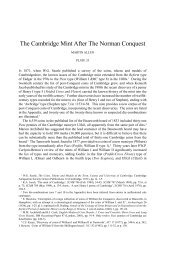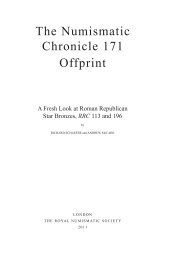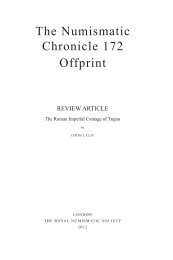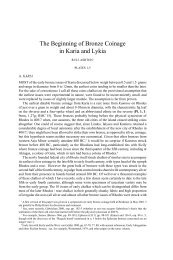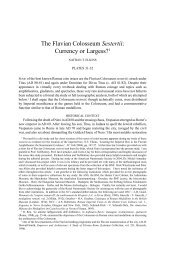Iolkos and Pagasai: Two New Thessalian Mints* - Royal Numismatic ...
Iolkos and Pagasai: Two New Thessalian Mints* - Royal Numismatic ...
Iolkos and Pagasai: Two New Thessalian Mints* - Royal Numismatic ...
You also want an ePaper? Increase the reach of your titles
YUMPU automatically turns print PDFs into web optimized ePapers that Google loves.
34<br />
KATERINI LIAMPI<br />
the coins of Morgantina of the time of Timoleon 87 <strong>and</strong> of Pixodaros, satrap of<br />
Caria. 88<br />
The laurel-wreath rules out the identification of the head as the hero-founder<br />
Pagasos, said to have been one of the Hyperboreans (Paus. I, 5, 8), but it <strong>and</strong> the<br />
seven-stringed lyre on the reverse strongly suggest Apollo, presumably the local<br />
Apollo <strong>Pagasai</strong>os (Etym. Magn. 646, 39) or Pagasites (Hesych., s.v.<br />
���������). 89 Herakleides Pontikos (Schol. ad Hes., Sc. 70= 137, fr. III<br />
{Tresp}) <strong>and</strong> the Scholia to Apollonios Rhodios (Argon. I, 238) both refer to a<br />
sanctuary of Apollo <strong>Pagasai</strong>os, while the poet himself mentions the god’s altar,<br />
which was built by the Argonauts before their expedition <strong>and</strong> on which they<br />
sacrificed (Argon. I, 359-60, 402-47). Hesiod (Sc. 70) refers to the grove of<br />
Apollo <strong>Pagasai</strong>os where his altar stood. Arvanitopoulos believes that Apollo<br />
<strong>Pagasai</strong>os was also honoured in <strong>Pagasai</strong> in Archaic times with other epithets, all<br />
mentioned by Apollonios Rhodios (Argon. I, 359, 404, 966, 1186). 90 He regards<br />
Apollo Koropaios as a late form of <strong>Pagasai</strong>os. 91 The lyre on the reverse is<br />
connected with Apollo in his role as Kitharoidos, <strong>and</strong>, either full figure or head,<br />
he is depicted on <strong>Thessalian</strong> coins as Kitharoidos or Mousagetes, attesting the<br />
musical tradition of the region during Classical <strong>and</strong> Imperial times. 92<br />
The coinage of <strong>Pagasai</strong> was modest, to judge from the single known coin,<br />
although more pieces may well turn up in future excavations. Its terminus ante<br />
quem is the foundation of Demetrias, after which <strong>Pagasai</strong> soon declined into a<br />
village. The terminus post quem is likely to be 354/353 BC, when the city was<br />
liberated by Philip II, after his ejection of the Pheraian tyrants. As we have seen,<br />
a date around the middle of the 4th century BC is also suggested by stylistic<br />
criteria. Scholars such as Beloch, Arvanitopoulos, Stählin <strong>and</strong> Bousquet 93 have<br />
remarked on the lack of Pagasitan coinage, although it was an economically<br />
powerful polis. I suggest that the Pheraian tyrants had drained the city of its<br />
wealth <strong>and</strong> inhibited the issue of coinage.<br />
It is difficult to determine whether these small issues of <strong>Pagasai</strong> <strong>and</strong> <strong>Iolkos</strong><br />
should be dated immediately after the capture of <strong>Pagasai</strong> in 354/353 BC or after<br />
Pherai came finally into the h<strong>and</strong>s of Philip II in 344/343 BC. The head of<br />
Artemis Iolkia supports the lower chronology because of the striking stylistic<br />
87<br />
SNG Ashmolean 1857.<br />
88<br />
Weber 6608.<br />
89<br />
Kruse 1942, col. 2309, s.v. <strong>Pagasai</strong>os; Moustaka 1983, p. 36.<br />
90<br />
Arvanitopoulos 1928, p. 77.<br />
91<br />
IG IX 2, 1109, l. 9-10. Arvanitopoulos (1928, p. 76) believes that the oracle of the god,<br />
established by Trophonios, was transferred to Korope, a more peaceful <strong>and</strong> suitable spot for oracles.<br />
92<br />
Moustaka 1983, pp. 36-8; Moustaka 1997, pp. 89-93; for the Imperial period, see Franke 1992,<br />
pp. 370-5, Pl. 81.<br />
93 Beloch 1911, p. 443; Stählin 1924, p. 67; Arvanitopoulos 1928, p. 79; Bousquet 1988, p. 184<br />
(with n. 11). Beloch 1914, p. 82, describes <strong>Pagasai</strong> as the ‘Haupthafen von Thessalien’ <strong>and</strong> a<br />
‘blühende H<strong>and</strong>elsstadt’.



